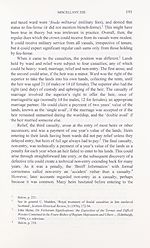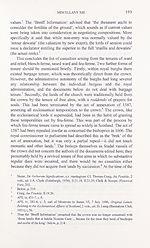Series 5 > Miscellany [of the Scottish History Society] XIII
(207) Page 192
Download files
Complete book:
Individual page:
Thumbnail gallery: Grid view | List view

192
FISCAL FEUDALISM
estate of an indebted predecessor, as this was the point at which they
incurred liability for the debts.1
These casualties were considerably reduced in the other forms of
tenure. Blench-ferme lands were subject to non-entry but not to ward or
marriage, and a relief could be only a double payment of the annual
reddendo (which was rarely substantial).2 Taxed ward was a variant of
ward and relief, in which definite, limited values (hence ‘taxed’) were
assigned in the charter to the casualties of ward, relief and marriage.
Ward became a fixed annual sum payable to the crown, relief a single
payment usually the same as the annual value of the ward, and marriage a
multiple of that sum (often five times). Usually non-entry was added to
the figure to which ward was taxed, thus precluding any claim for non¬
entry unless there was non-entry with no prior ward. The right and duty
of custody of the heir could not be disponed by the crown, but fell as of
right to the heir’s nearest adult kinsman on the father’s side, who also
gained the lands during the wardship and paid the crown its dues. There
could be variations on this; the ‘Breiff Information’ noted charters in
which the relief was taxed but not the ward or marriage.3 As for feu-
ferme, the only casualty was a double payment of the feu-duty at the
entry of an heir, equivalent to relief.
The valuation of land for the feudal casualties was not normally
calculated at the current rental value. There were no public valuations of
land at current prices in early modem Scotland before 1639, because
landlords resisted the making of such valuations in the knowledge that
they would lead to increased taxation. Instead ‘new extent’ was used, a
valuation created in 1366 which went alongside ‘old extent’ which was
used for parliamentary taxation and the parliamentary franchise.4 The
casualty of marriage was a partial exception in that it could be ‘modified
and liquidat be the Lordes of the Session, to ane certaine summe of
money, after consideration of the rentall’—that is, by reference to current
1 Some attempted to have themselves entered heir to someone else (such as a grandfather
rather than an indebted father), a practice which attracted legislation in 1695: APS, ix,
427-8, c. 39.
2 Sir Thomas Hope, Major Practicks, 2 vols., ed. J.A. Clyde (Stair Society, 1937-8),
ni.25.13. It could be called the ‘duplicand’ (duplicatio) rather than relief.
3 Below, p. 216.
4 R. Nicholson, Scotland: the Later Middle Ages (Edinburgh, 1974), 174-6; J. Goodare,
‘Parliamentary taxation in Scotland, 1560-1603’, Scottish Historical Review, Ixviii
(1989), 23-52, at pp. 24-6; T. Thomson, Memorial on Old Extent, ed. J.D. Mackie (Stair
Society, 1946), 149-51,304.
FISCAL FEUDALISM
estate of an indebted predecessor, as this was the point at which they
incurred liability for the debts.1
These casualties were considerably reduced in the other forms of
tenure. Blench-ferme lands were subject to non-entry but not to ward or
marriage, and a relief could be only a double payment of the annual
reddendo (which was rarely substantial).2 Taxed ward was a variant of
ward and relief, in which definite, limited values (hence ‘taxed’) were
assigned in the charter to the casualties of ward, relief and marriage.
Ward became a fixed annual sum payable to the crown, relief a single
payment usually the same as the annual value of the ward, and marriage a
multiple of that sum (often five times). Usually non-entry was added to
the figure to which ward was taxed, thus precluding any claim for non¬
entry unless there was non-entry with no prior ward. The right and duty
of custody of the heir could not be disponed by the crown, but fell as of
right to the heir’s nearest adult kinsman on the father’s side, who also
gained the lands during the wardship and paid the crown its dues. There
could be variations on this; the ‘Breiff Information’ noted charters in
which the relief was taxed but not the ward or marriage.3 As for feu-
ferme, the only casualty was a double payment of the feu-duty at the
entry of an heir, equivalent to relief.
The valuation of land for the feudal casualties was not normally
calculated at the current rental value. There were no public valuations of
land at current prices in early modem Scotland before 1639, because
landlords resisted the making of such valuations in the knowledge that
they would lead to increased taxation. Instead ‘new extent’ was used, a
valuation created in 1366 which went alongside ‘old extent’ which was
used for parliamentary taxation and the parliamentary franchise.4 The
casualty of marriage was a partial exception in that it could be ‘modified
and liquidat be the Lordes of the Session, to ane certaine summe of
money, after consideration of the rentall’—that is, by reference to current
1 Some attempted to have themselves entered heir to someone else (such as a grandfather
rather than an indebted father), a practice which attracted legislation in 1695: APS, ix,
427-8, c. 39.
2 Sir Thomas Hope, Major Practicks, 2 vols., ed. J.A. Clyde (Stair Society, 1937-8),
ni.25.13. It could be called the ‘duplicand’ (duplicatio) rather than relief.
3 Below, p. 216.
4 R. Nicholson, Scotland: the Later Middle Ages (Edinburgh, 1974), 174-6; J. Goodare,
‘Parliamentary taxation in Scotland, 1560-1603’, Scottish Historical Review, Ixviii
(1989), 23-52, at pp. 24-6; T. Thomson, Memorial on Old Extent, ed. J.D. Mackie (Stair
Society, 1946), 149-51,304.
Set display mode to:
![]() Universal Viewer |
Universal Viewer | ![]() Mirador |
Large image | Transcription
Mirador |
Large image | Transcription
Images and transcriptions on this page, including medium image downloads, may be used under the Creative Commons Attribution 4.0 International Licence unless otherwise stated. ![]()
| Scottish History Society volumes > Series 5 > Miscellany [of the Scottish History Society] XIII > (207) Page 192 |
|---|
| Permanent URL | https://digital.nls.uk/127316013 |
|---|
| Description | Over 180 volumes, published by the Scottish History Society, containing original sources on Scotland's history and people. With a wide range of subjects, the books collectively cover all periods from the 12th to 20th centuries, and reflect changing trends in Scottish history. Sources are accompanied by scholarly interpretation, references and bibliographies. Volumes are usually published annually, and more digitised volumes will be added as they become available. |
|---|


